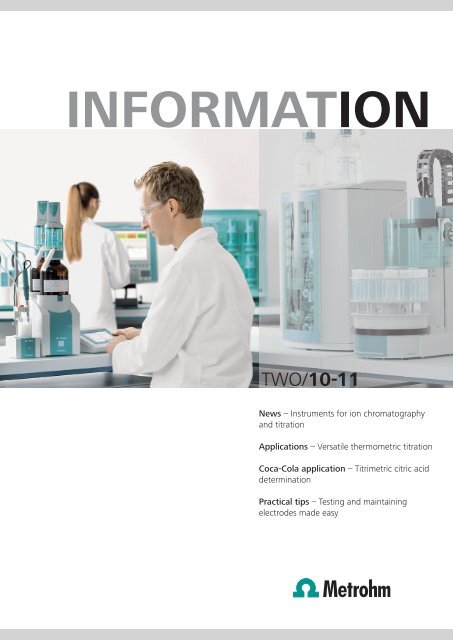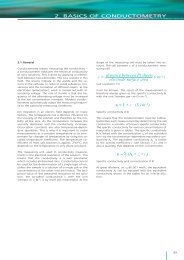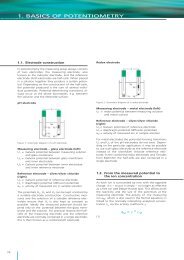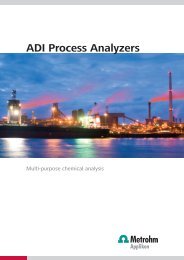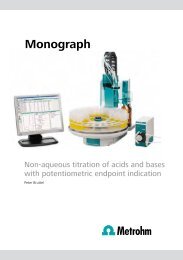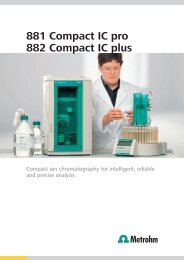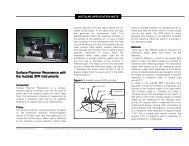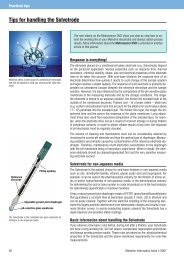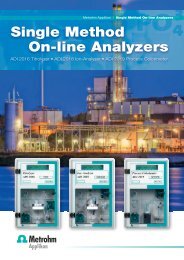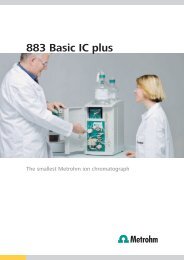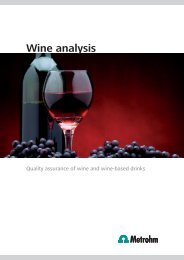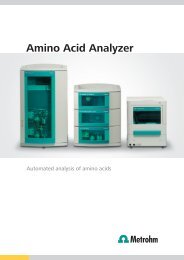Download (PDF) - Metrohm
Download (PDF) - Metrohm
Download (PDF) - Metrohm
Create successful ePaper yourself
Turn your PDF publications into a flip-book with our unique Google optimized e-Paper software.
INFORMATIONTWO/1011News – Instruments for ion chromatographyand titrationApplications – Versatile thermometric titrationCoca-Cola application – Titrimetric citric aciddeterminationPractical tips – Testing and maintainingelectrodes made easy
02Dear readers,Less than 10 years ago, most of the 900 or so people taking partin the Fall Meeting of the Swiss Chemical Society broke new groundfor themselves. They embarked on a course in chemistry either hereat the Swiss Federal Institute of Technology (ETH) in Zurich, the venuefor the Fall Meeting, or at other universities in Switzerland or in othercountries. Today they are presenting their work on more than 600posters, in talks and publications. Two thirds of the participants arebelow the age of 30. This new ground has produced competentscientists, who will form the backbone of chemical activities inSwitzerland and beyond its borders. However, support is needed,so that viable routes can be created over this new ground. This supportcomes from private sponsors, including the <strong>Metrohm</strong> Stiftung(<strong>Metrohm</strong> Foundation), which this year is giving awards for the bestposters and presentations. We wish the winners the best of luck asthey continue their careers in the academic or industrial world.<strong>Metrohm</strong>'s new instruments offer everything you need to breaknew ground. The analysis of amino acids requires two things: cooledsamples to reduce biological degradation processes drastically and120 °C of heat to carry out postcolumn derivatization in accordancewith USP (Method 1). In this connection, <strong>Metrohm</strong> nowpresents a series of new components: the 889 IC Sample Center withcooling, the 887 Professional UV/VIS Detector and the 886 ProfessionalThermostat / Reactor, with which as many as 17 amino acidscan be separated on a suitable Metrosep column.To explore new ground, the complete spectrum can be recordedat any point on the chromatogram with the 887 Professional UV/VISDetector. Combined with the intelligent column, the intelligent reactorprovides the reliability that is needed. Of course, the «traditional»components, such as chromate, bromate and heavy metals can alsobe determined reliably with this combination of instruments.Even in a familiar environment there are new things to bedis covered. If you thought titration was characterized only bytradition and not by innovation, thermometric titration will provethe opposite to you. Chemical reactions are linked to a change inthe heat of reaction (enthalpy of reaction) and therefore producea temperature change in the reaction solution. A highly sensitivetemperature sensor can record this. With thermometric titration itis now possible to measure and evaluate the temperature changeinstead of the potential change. Consequently, in critical samples, the859 Titrotherm is sometimes the only possibility to achieve reliableresults.Though chips are widely enjoyed while watching a game on TVand are an integral part of the electronic circuits of the TV itself,they have up to now rarely been used as sensors in titration. Thefirst to be presented by <strong>Metrohm</strong> are the new ion-selective scIONelectrodes, which are based on a printed circuit. These chips are usedto determine calcium and provide excellent results.Editorial
03Investment in the future: The <strong>Metrohm</strong> Stiftung (<strong>Metrohm</strong> Foundation) supports scientists as well as educational projects.We would now like to invite you to join us in breaking newground in this issue of <strong>Metrohm</strong> Information and hope you enjoyyour reading.Dr. Kai Henning ViehwegerPresident, Division Manager Sales and MarketingINFORMATION | 2 | 2010-11
04Table of contentsEditorial• <strong>Metrohm</strong> helps you to break new ground 02News• 887 Professional UV/VIS Detector and 886 Professional Thermostat / Reactor 05• Professional ion chromatography from <strong>Metrohm</strong> 08• Affordable 885 Compact Oven Sample Changer for KF titrations 09• Cost-effective Ca/Mg titration with scION electrodes 12• Proven Solvotrode with new easyClean diaphragm 14Customer application report• Titrimetric citric acid determination at Coca-Cola Services Belgium 16Application reports• Practical applications of thermometric titration 20• Determination of heavy metals in particulate matter 24Practical tips• Testing and maintaining electrodes made easy 28<strong>Metrohm</strong> Quality Service• «Prevention is better than cure» or «What is Good Care Practice?» 32<strong>Metrohm</strong> publications• New <strong>Metrohm</strong> Multimedia Guide «Electrodes in Voltammetry» 36• New Application Bulletins and scientific articles 38• New <strong>Metrohm</strong> brochures at a glance 40Literature references• Literature references from the field of ion analysis 42Seminars and trade fairs• Information on <strong>Metrohm</strong> seminars and trade fairs 46Inhalt
887 Professional UV/VIS Detector and 886 ProfessionalThermostat / Reactor bring on the colors 05887 Professional UV/VIS Detector and 886 Professional Thermostat / Reactor add UV/VIS detection to Professional IC and Compact IC instrumentsand open up a whole field of new applications.In ion chromatography, UV/VIS detection is an establishedalternative to conductivity detection. The new 887 ProfessionalUV/VIS Detector adds UV/VIS detection to theProfessional IC and Compact IC instruments and extendsthe range of applications considerably. The instrument isoperated by the user-friendly MagIC Net software andallows a wide variety of analytes to be determined by director indirect detection. In addition, <strong>Metrohm</strong> is launching the886 Professional Thermostat / Reactor, which can be usedfor precolumn or postcolumn reactions to generate UV/VISactivecompounds.Broad range of uses for the UV/VIS detectorThe 887 Professional UV/VIS Detector enables reliable and accuratequantification of substances that absorb light in the ultraviolet orvisible wavelength range. They can be determined by means of director indirect extinction. The flow path of <strong>Metrohm</strong>’s IC instrumentsis completely metal-free, as the measuring cell is made of PEEK.Thus, not only the standard anions and cations, but also transitionmetal ions and various organic substances can be detected withoutany problem. Even in complex matrices (e.g., biological samples)good detection limits can be achieved on the basis of the specificabsorption properties of many analytes. The 887 Professional UV/VISDetector is an alternative to the well-established conductivity detectorand extends the family of intelligent detectors from <strong>Metrohm</strong>. All<strong>Metrohm</strong> detectors can be swapped round or combined with eachother in a flexible way. The 887 Professional UV/VIS Detector can becombined with both 850 Professional IC and 881/882 Compact ICinstruments.INFORMATION | 2 | 2010-11
06The 887 Professional UV/VIS Detector is based on diode array technologyand enables reliable quantification of substances that absorb light in theultraviolet or visible wavelength range.The 887 Professional UV/VIS Detector is a diode array detector(512 diodes) that can be used for a variety of applications withextinctions throughout the UV/VIS wavelength range. Maximumflexibility in method development is supported by the possibility ofindividualized settings for data collection. For substances with different absorption maxima, there are 8 measuring channels available.Furthermore, data of the first 4 measuring channels can be read outvia an analog output. A spectrum can be recorded at any time duringa measurement. The extensive range of possibilities for data evaluationallows the user to obtain, for example, up to 10 absorptionmaxima of a spectrum automatically. That makes it easier to choosethe optimum wavelength for a particular application.With additional precolumn or postcolumn derivatization, manymore substances can be transformed into UV-active or VIS-activemolecules, which can also be detected with the 887 Professional UV/VIS Detector. Thus, the range of possible applications is extendedeven further.An ideal complement: the 886 Professional Thermostat /Reactor for derivatizationsThe 886 Professional Thermostat / Reactor is the ideal complementto your analytical system for carrying out derivatizationsof all kinds. Its robust design and reaction temperatures of up to150 °C open up a diversity of possible uses for the 886 ProfessionalThermostat / Reactor. Traceability and monitoring are guaranteedby means of a data chip. This integral component of the intelligentIC concept minimizes operator errors and improves the reliability ofanalysis throughout the analytical system. The instrument also hasmetal-free flow paths and can serve as host for other 872 ExtensionModules, such as modules with additional pumps or valves. The 886Professional Thermostat / Reactor can be used either as a heatableprecolumn and postcolumn reactor or as a column thermostat.The 886 Professional Thermostat / Reactor (top) is available in two versions.It can be operated either as a heatable reactor for precolumn or postcolumnderivatizations (version 1, left insert) or as a thermostat for column heating(version 2, right insert).News
07650600550500450GlyIntensity [mAU]40035030025020015010050AspSerThrGluProAlaValCysMetIle LeuTyrPhe00 5 10 15 20 25 30 35 40 45 50 55 60 65 70 75 80 85 90Time [min]NH 3LysHisArgIon chromatographic determination of amino acids on an 850 ProfessionalIC with the help of 886 Professional Thermostat / Reactor and887 Professional UV/VIS Detector. Amino acids: 20 components each of0.5 mM, column: Metrosep Amino Acids 1 - 100/4.0, eluent: lithium citrategradient as per USP (Method 1), 0.4 mL/min, 60 °C, postcolumnreaction: ninhydrin reagent, 0.2 mL/min, 120 °C, wavelength 570 nm.Your benefit: a wide range of applicationsA wide range of applications can be covered with the 887Professional UV/VIS Detector. Direct extinction measurements enableanalytes such as nitrogen compounds (NO 2– , NO 3– ), sulfur compounds(S 2– , S 2O 32–, SO 32–), halogen compounds (IO 3– , Br – , I – ), organic acids,vitamins, sweeteners, caffeine, melamine and many other ions to bedetermined. Moreover, it is possible to quantify transition metals,chromate, bromate, silicate, cyanide, cyanogen chloride, aluminumand amino acids after postcolumn derivatization. With precolumnderivatization, complexing agents such as EDTA, NTA, PBTC andTHPC can also be determined using UV/VIS detection.The new generation of UV/VIS instruments extends the rangeof applications of Professional IC and Compact IC instrumentscon siderably. The <strong>Metrohm</strong> user benefits from the great advantages(e.g. traceability, reliability of analysis...) provided by an intelligentdetector in conjunction with the MagIC Net software.INFORMATION | 2 | 2010-11
10The cost-effective 885 Compact Oven Sample Changer is ideal for thermal sample preparation of granules from the plastics industry or for mineral oils.Advantages of the 885 Compact Oven Sample ChangerSmall footprintThe name of the 885 Compact Oven Sample Changer says it all:the instrument provides automation in a very small space. After thesample has been weighed in, the hermetically sealed vials are simplyplaced on the sample rack and the sample series is started. Onesample after the other is then automatically delivered for analysis.Great flexibilityDepending on the water content of the sample, Karl Fischertitration can be performed coulometrically or volumetrically. It doesnot matter which method is used. The 885 Compact Oven SampleChanger can be operated with all stand-alone Karl Fischer titratorsthat have a built-in sample data silo*.Easy to useThe 885 Compact Oven Sample Changer is controlled via theintegrated keypad. Only the oven temperature and the gas flow needto be defined and the number of test samples set. That’s how easyand efficient automated Karl Fischer titration can be!Reusable sample vialsScrew-cap vials are used for the 885 Compact Oven SampleChanger. After measuring, these sample vials can be opened andcleaned without any problem and then reused. Only the piercedseptum needs to be replaced.The double hollow needle pierces the septum of the sample vial. The streamof dry carrier gas transports the evaporated water in the sample vial into thetitration cell via a transfer line.*Sample data silo = storage space for temporary storage of the sample tableNews
11The 885 Compact Oven Sample Changer can be used for sample preparationin both coulometric (bottom) and volumetric (top) Karl Fischer titration.Valuable tips and tricks on Karl Fischer titration are provided in our free<strong>Metrohm</strong> Multimedia Guide «What you always wanted to know about KarlFischer titration» (order number A.714.0004). Your <strong>Metrohm</strong> representativewill be happy to send you your own personal copy.INFORMATION | 2 | 2010-11
14Proven Solvotrode with new easyClean diaphragmThe new Solvotrode easyClean with the practical easyClean diaphragm.The Solvotrode is the proven sensor for space-savingacid/base titration in non-aqueous media (e.g. TAN/TBNaccording to ASTM D664, D4739, D2896 and DIN ISO 3771and DIN EN 1236).As a result of the special shielding against electrostatic interferenceand the flexible ground-joint diaphragm, it is specificallyoptimized for these applications.The new Solvotrode easyClean is a further development in whichthe flexible ground-joint diaphragm has been replaced by the neweasyClean diaphragm. The latter offers the following advantages:• Easy contact-free cleaning of the diaphragm• Greater accuracy and reproducibility of the electrolyte flow• Reduced immersion depth of the sensorNews
15«Easy cleaning» of the diaphragm: Just press once on the electrodehead and the electrolyte flows out. The diaphragm that was incontact with the sample does not need to be touched any more forcleaning.Solvotrode easyClean – just press on the electrode head to clean theelectrode.INFORMATION | 2 | 2010-11
17Headquarters of the Belgian Coca-Cola Services Company in Anderlecht.Requirements for a new systemThe parameters to be determined by the new system were pHvalue and citric acid concentration in different beverages. As a vastamount of products has to be checked, the workload in the lab ofCoca-Cola Services (the Belgian subsidiary of the Coca-Cola Company)is very high. Therefore, it is of great importance, that a suitableanalysis system not only provides accurate and reliable results, butalso has a high throughput and even the ability to run many samplesunattended over night. Moreover, all different sample types have tobe handled without manually adapting the workstation each time.As the sample preparation (pipetting) of this vast amount of samplesis very time-consuming and error-prone, Coca-Cola Services likedthe idea of an automated system that also offers a reproducible andprofessional sample preparation right from the start.The fully automated titration systemThe fully automated titration system actually consists of two814 USB Sample Processors with two external titration vessels andone 808 Titrando with two measurement inputs, an 805 Dosimat,two 772 Pump Units, two 800 Dosinos with Dosing Units, an802 Stirrer (propeller stirrer) and an 804 Ti Stand. Both set-ups areequipped with sample racks that can handle up to 127 vials with avolume of 11 mL sample each. The sample transfer is carried out bya Dosino-controlled pipetting tube with a specially-designed needlethat can also handle sample containing pulp.INFORMATION | 2 | 2010-11
18Julie Tilquin is the responsible lab technician for the fully automated <strong>Metrohm</strong> titration system.The determinationThe determination is carried out automatically. Thus, afterdegassing, the only manual task is placing the beverage samples onthe sample rack and filling the sample data table with the appropriatesample data. Automatically, 10 mL sample is pipetted to the externaltitration cell where some additions of auxiliary solutions take place.After calibrating of the electrode, the citric acid titration is per formed.Pipetting, measuring, titrating and cleaning of the equipment aredone fully automatically in one run.Data evaluationThe titration system is controlled completely by <strong>Metrohm</strong>‘swell-proven titration software tiamo. With the installed tiamomulti version, the results of different workplaces can be checked fromany office desk within only a few steps using the intuitive and wellarranged user interface. The database provides all necessary tools formanaging results, searching for them and grouping them together.Quick filters allow a fast search through thousands of determinations.Control charts provide a rapid overview of the chronologicalsequence of the results. tiamo is compliant with the demands ofFDA Regulation 21 CFR Part 11.Customer application report
19ConclusionThe European Quality Centre in Brussels has worked with thesystem since February 2005 and is extremely satisfied as all requirementsare fulfilled:• high throughput• fast and time-saving analysis• good accuracy and reproducibility• reliable system, that even provides unattended operationover night• rapid and competent support by <strong>Metrohm</strong> if neededAn enormous amount of various beverage samples can besucessfully prepared and analyzed with a fully automated customtailoredsolution from <strong>Metrohm</strong>. The citric acid concentration of thesamples can be monitored conveniently from the office desk.We would like to thank Julie Tilquin from Coca-Cola Services forher assistance in writing this article.Close-up of the specially-designed needle for the aspiration of even pulpysamples.INFORMATION | 2 | 2010-11
20 Practical applications of thermometric titrationEach chemical reaction is associated with a change inenthalpy that causes a temperature change. The increase(exothermic reaction) or reduction (endothermic reaction)in temperature depends on the amount of substanceconverted.In a thermometric titration, reagent solution (titrant) is addedto the sample at a constant rate until the endpoint is reached. Thechanging temperature of the reaction solution is plotted versus thevolume of titrant added. The titration endpoint can be recognizedby a break in the titration curve and is exactly determined via thesecond derivative. Since the temperature sensor «Thermoprobe»has a response time of 0.3 s and a resolution of 10 -5 K, even smallenthalpy changes are reliably monitored.The most important advantages of thermometric titration are:• Problem solver for difficult samples that cannot be titratedpotentiometrically• Easy-to-learn and perform method fully supported in the tiamotitration software• Results are obtained very fast• One sensor for all applications• Maintenance-free sensor• No sensor calibration required• Robust method for routine work• No membrane or diaphragm problems• Well suited for aggressive media<strong>Metrohm</strong>’s application lab has been very busy developing newapplications for thermometric titration – we are proud to introduce anumber of new Application Bulletins. They can be downloaded freeof charge with the corresponding ready-to-use tiamo methodsfrom our website products.metrohm.com – simply enter the documentnumber of the Application Bulletin into the search field. The zipfile you download contains the Application Bulletin as a pdf file andthe tiamo methods.Application report
21859 Titrotherm from <strong>Metrohm</strong> for the thermometric titrationAB-298Automated sodium determination in various foodsConsumers and regulatory agencies are pushing harder thanever for the accurate analysis of sodium in food products. Directmeasurement methods like atomic absorption spectroscopy (AAS)or inductively coupled plasma spectroscopy (ICP) are very costandtime-consuming for testing labs. For this reason, many foodcompanies have indirectly analyzed sodium by using the results ofchloride analysis. The amount of sodium is then typically calculatedby assuming a 1:1 molar ration of chloride ions to sodium ions inthe food. This is not necessarily the case especially when commonsodium-containing food ingredients, such as sodium benzoate andmonosodium glutamate, or chloride-containing ingredients such aspotassium chloride, are present in the food matrix.To determine the amount of sodium in foodstuffs, no cumbersomemanual sample preparation steps are necessary. The food is firsthomogenized fully automatically by a high-frequency homogenizerPolytron 1300D - (which can be mounted on a USB Sample Processor).Then, ammonium hydrogen difluoride is added to the sample,followed by a thermometric titration with a standardized aluminumsolution which contains a stoichiometric excess of potassium ions. Inthis exothermic reaction, insoluble NaK 2AlF 6 is obtained:Al 3+ + Na + + 2K + + 6F –NaK 2AlF 6
24AB-307, AB-308, AB-314, AB-316Determination of sulfate and phosphate in variousfertilizersThis series of Application Bulletins deals with the determinationof sulfate and phosphate in liquid fertilizers and granular fertilizerssuch as MAP (monoammonium phosphate), DAP (diammoniumphosphate) and TSP (triple superphosphate). Sulfate can be rapidlyand easily titrated thermometrically using a standard solution of Ba 2+as titrant. This procedure is already used for the determination ofsulfate in wet-process phosphoric acid. Results are reported as percentageof elemental sulfur (%S).Phosphate can be rapidly and easily titrated thermometrically usinga standard solution of Mg 2+ as titrant. This titrimetric phosphatedetermination method is based on a classical gravimetric procedure.The phosphate-containing solution is buffered with NH 3/NH 4Clsolution immediately before the titration. The formation of insolubleMgNH 4PO 4 is exothermic. Results are reported as percentage of Pand P 2O 5. The phosphoric acid content in liquid fertilizers can beeasily titrated thermometrically with a standardized NaOH solutionc(NaOH) = 2 mol/L. The interfering calcium content in phosphoricfertilizer can be eliminated by adding a saturated oxalate solution.AB-313Determination of total caustic, total soda and alumina inBayer process liquorsTotal caustic 1 , total soda 2 and the aluminum content (as alumina)of aluminate liquors from the Bayer process have to be determined.This can be accomplished with high precision and speed by using athermometric acid-base titration. A complete titration to determineall three parameters takes approximately five minutes. The procedureis an automated adaptation of the traditional Watts-Utley method 3 ,and is similar to the Van Dalen-Ward thermometric titration method 4 ,but with the added advantage of being able to analyze the carbonatecontent of the liquor as well.An aliquot of Bayer liquor is dispensed into a titration vessel. Potassiumsodium tartrate solution is added to complex the aluminateion. One mole of hydroxide ions is released per each mole aluminateion present. These hydroxide ions, together with hydroxide ions alreadypresent in the liquor are titrated with standardized hydrochloricacid. The titration is permitted to continue so that carbonate ionspresent in the liquor are also titrated. The first titration is then automaticallystopped, and potassium fluoride solution added to breakthe alumino-tartrate complex and release 3 moles hydroxide ions pereach mole aluminum present. These liberated hydroxide ions are thentitrated with the standardized hydrochloric acid, and determined asthe alumina content of the liquor.
231total caustic = total hydroxide content of the liquor2total soda = the sum of the total caustic and carbonate contents3H. L. Watts and D. W. Utley, Anal. Chem. 28, 1731 (1956)4E. Van Dalen and L. G. Ward, Anal. Chem. 45, 2248 (1973)AB-315Determination of free fatty acids (FFA) in edible oilsIn a titration, the titrant reacts with the analyte either exothermically(gives off heat) or endothermically (absorbs heat). TheThermoprobe measures the temperature change during the titration.When all of the analyte has reacted with the titrant the temperaturealteration of the reaction solution changes and this is visible as atemperature curve inflection.However, in some cases the inflection in the temperature curveis not sufficient to evaluate a thermometric titration. In a titration ofsamples containing very weak acids, e.g., in rape oil, the endpointof the titration is difficult to identify. In these cases, catalyticallyenhanced titrations are the key to success. They rely on a catalyzedindicator reaction to get a sharp inflection in the titration curve. Theendothermic hydrolysis of paraformaldehyde in the presence of excesshydroxide is an example for such a catalyzed indicator reaction.It is used for the determination of FFA in edible oils and requiresadding a small amount of paraformaldehyde to the sample solutionprior to titration. As soon as all acidic compenents of the reactionsolution have been neutralized, further addition of titrant leads toan excess of hydroxide ions which starts the endothermic hydrolysisof the paraformaldehyde. This results in a sharp inflection in thetemperature curve.Edible oils are dissolved in a mixture of toluene and 2-propanol(1:1) and titrated with a standardized solution of tetrabutylammoniumhydroxide dissolved in 2-propanol (c(TBAH) = 0.01 mol/L) toa catalytically enhanced endpoint.The respective tiamo method is capable of displaying theresults as a percentage of free fatty acids (% FFA) or alternatively as atotal acid number (mg KOH/g).AB-341Determination of TAN in engine oil with 859 TitrothermThe method for the determination of TAN in engine oil or othermineral oils is basically the same as for determining free fatty acidsin edible oils.The Total Acid Number (TAN) is the amount of base (in mg KOHper g oil) that is required to neutralize the acids contained in theoil. The TAN is a measure of the acidity of the oil resulting from thepresence of acidic compounds formed by oxidation, degradation ofadditives or the introduction of acids.INFORMATION | 2 | 2010-11
24Determination of heavy metals in particulate matterSources of particulate matter: industry, burning of wood and fossil fuels, volcanic eruptions, sea spray, desert dust and erosion.When we breathe in, numerous airborne particles enter ourbody; depending on their size, they may become lodgedin the respiratory tract or further on in the gas exchangezone, the pulmonary alveoli.Secondary particulate matter is formed in the atmosphere bychemical reactions involving either waste gases from combustionprocesses or substances with an agricultural origin (SO x, NO x, NH 3,volatile organic compounds).Sources of particulate matterPrimary particulate matter comes from different sources. Someof the air pollution by particulate matter is of anthropogenic originand is caused both by the burning of wood and fossil fuels and byabrasion and swirling. In addition, natural sources such as volcaniceruptions, sea spray, desert dust and erosion also contribute to particulatematter pollution.Application report
25Particle sizesA mixture of particles with a diameter of less than 10 µm isknown as particulate matter or PM 10. These particles are small enoughto pass through the windpipe and into the lungs. Dust particles withdiameters less than 2.5 µm and 1 µm are referred to, respectively, asPM 2.5 and PM 1.FractionPM 10 (thoracic dust)PM 2.5 (respirable dust)PM 1Ultrafine particles (UFP)Size≤ 10 μm≤ 2.5 μm≤ 1 μm≤ 0.1 μm
27Semi-continuous voltammetricdetermination of heavy-metalconcentrations (Cd, Pb and Cu) inambient air with the help of a PILSsampling system.Schematic setup of a PILS sampling systemA vacuum pump draws in ambient air at a flow rate of 1 m³/hand transports it through the supersaturated steam produced in thePILS from ultrapure water. The particles from the aerosol grow intodroplets in the steam and at the end are collected on an impactorplate. As a result, sufficient sample solution for the subsequentanalysis can be generated in a short time.By combining PILS with a voltammetric measuring system suchas the 797 VA Computrace, it is possible to quantify various heavymetals (cadmium, lead, zinc, copper, nickel, cobalt etc.) in particulatematter with a temporal resolution of approximately 30 minutes.Example of a measurement of cadmium, lead and copper inambient airFor the example shown, the concentrations of heavy metals inambient air were monitored continuously for a period of three days.After collecting a sample with PILS, the concentrations of the heavymetals cadmium, lead and copper were determined voltammetrically.The steady increase in heavy metal concentrations is clearly evident.When rain started to fall, it cleaned the air and as a result themeasured concentrations of lead and copper decreased noticeably.INFORMATION | 2 | 2010-11
29This AB also provides you with useful general tips on pHmeasurement and the use of electrodes – for the best results in yourlaboratory!Free guide to maintenance and care on DVDA lot of useful advice on general handling of electrodes canalso be found on the free DVD «Maintenance and Care of <strong>Metrohm</strong>Electrodes» (order number A.740.0001). Numerous short videosequences with easy-to-follow step-by-step instructions make it easyfor you to look after your sensors. Your <strong>Metrohm</strong> representative willbe happy to send you a free copy.Become a minimalist!Would you like to determine pH values reliably without caringtoo much about maintenance? Your wish can be met by our newEcotrode Gel pH electrode with maintenance-free gel electrolyteand aging indicator (left electrode: 6.0221.100 without temperaturesensor, electrode in the middle: 6.0221.600 with temperaturesensor). The aging indicator shows you at a glance whether yourelectrode provides reliable results or needs to be replaced.Our new Solvotrode easyClean (right electrode; see also articleon page 14) for titration in non-aqueous media can be cleanedeasily and more quickly. Just press once on the electrode head andthe electrolyte flows out. This makes cleaning and filling with newelectrolyte child’s play.Buying wisely to save cleaningIf you need a new electrode for your titration applicationsor pH measurements, you should have a look at our free buyingguides (available from your <strong>Metrohm</strong> representative or as a downloadfrom http://products.metrohm.com; for titration applications:8.000.6003EN, for pH measurements: 8.000.6001EN). They shownot only typical uses and types of sample but inform you also on themain electrode properties and give you tips on storage and cleaning/care. By choosing the right electrode, you will not only obtain thebest possible results but will also be able to considerably cut downthe amount of cleaning and maintenance required.INFORMATION | 2 | 2010-11
30A sensor also needs to rest and recover. <strong>Metrohm</strong>’s pHit kit cleans your pH electrodes gently and easily. By using the kit regularly, you can extend the lifetimeof your sensor considerably.Give your pH electrode a treat with the pHit kitOnly regular care of the glass membrane and the diaphragm ofyour pH electrode will ensure reliable results over a long period. Adirty glass membrane or diaphragm may lead to unstable measuringvalues, longer conditioning times and incorrect results.However, etching with toxic chemicals or mechanically cleaningthe diaphragm is not exactly what your electrodes deserve. This is notonly complicated and expensive but will also accelerate aging of yourpH glass electrodes.With <strong>Metrohm</strong>’s pHit kit (6.2325.000) you can clean and regenerateyour pH glass electrodes gently and safely with liquid electrolytes.By using the pHit kit regularly, you can extend their lifetimeconsiderably. The pHit kit contains:• 50 mL bottle of ready-to-use potassium chloride electrolytesolution c(KCl) = 3 mol/L for refilling the electrode• 50 mL bottle of storage solution for optimized storage. Theresponse times of the electrode remains short even afterextended storage periods (unlike after conventional storage in3 M KCl)• 50 mL bottle of universal cleaning solution for gentle andenvironmentally friendly cleaning of the electrode• two electrode storage vessels for convenient cleaning in thecardboard stand of the pHit kit box• detailed leaflet with step-by-step instructionsIf you are working with several electrodes, then we recommendyou the optional electrode stand (6.2615.050), which can holdeleven electrodes and three 50 mL bottles.The advantages of the pHit kit at a glance• Easy and gentle cleaning of pH electrodes with liquid electrolytes• Good results both in troubleshooting and as a preventive measure• Considerably extended lifetime of your electrodes as a result ofregular cleaning<strong>Metrohm</strong> assists you not only to maintain your titrationequipment. If you have one of the latest generation <strong>Metrohm</strong>ion chromatographs, we recommend our «Brief instructions onmaintaining your <strong>Metrohm</strong> ion chromatograph» (http://products.metrohm.com, 8.000.5040EN).Practical tips
The pHit kit is so easy to use311. Rinse the outside of the pH electrode with distilled water.2. Fill cleaning solution into the electrode storage vessel.3. Immerse the electrode in the cleaning solution beyond thediaphragm and let the solution take its effect.4. Empty the electrolyte chamber completely.5. First rinse the electrolyte chamber with new electrolyte and thenrefill it.6. Exchange the storage solution in the electrode storage vessel.7. Condition the clean electrode in storage solution; then use it inthe normal way, or leave it in solution and store it.High-quality <strong>Metrohm</strong> electrodes, preventive maintenance andobservance of our care tips are the best way to ensure consistentlyprecise results – throughout the lifetime of a sensor. If you still haveany questions about our electrodes, we’d be happy to help you. Wedo everything to make your day in the laboratory easier and bring asmile to your face!
32«Prevention is better than cure» or«What is Good Care Practice?»«Prevention is better than cure». Does this saying soundfamiliar to you? It might well do. It is also used intoothpaste advertising. But what does this phrase haveto do with <strong>Metrohm</strong> Quality Service? Quite a lot! Goodcare and prevention are important not only for your teeth,but also of course for your analytical instruments from<strong>Metrohm</strong>.Nature has given us a set of teeth that are designed to see usthrough all our adult years. Of course, <strong>Metrohm</strong> doesn’t go quiteso far – figuratively speaking. You can obtain new state-of-the-artanalytical instruments from us at any time. However, when ourcustomers buy a <strong>Metrohm</strong> instrument, they expect their investmentto be worthwhile and to perform its task reliably for a number ofyears. Because of their high quality, our products are ideally equippedto meet this expectation. Our long-term tests and feedback fromcustomers confirm this high quality time and time again in a veryimpressive way. However, even the best product quality is hardlyenough on its own to be able to guarantee that an instrument willhave a long life. Which takes us back to your teeth.
33Preventive care on your part guarantees a firm biteEven if you are lucky and have inherited good teeth from yourparents, you still need to clean your teeth every day and visit yourdentist regularly. After all, only those people who look after theirteeth properly and regularly can be sure of being able to «continuebiting firmly into the future» (as claimed by an advertising sloganfrom Procter & Gamble that is used for blend-a-med toothpaste inGermany).The same applies with regard to your <strong>Metrohm</strong> instruments.After all, you have decided to buy a top-quality product. But, in orderfor you to be able to carry out your analyses with it over many, manyyears and to be able to rely on the best possible measurement results,it requires careful handling and regular care.Ask yourself what you or your employees in the laboratorycan do regularly to ensure that the performance and accuracy aremaintained over the long term. As an example, sometimes the unexpectedhappens and a chemical is spilled. To prevent any damage,it is important that you give your employees precise instructions onwhat they should do in such cases. Don’t be frightened to point outthe possible consequences and resultant costs. Preventive care andawareness are the key terms here.Alarm systems prevent major damageWe do all we can to make it as easy as possible for you to lookafter your <strong>Metrohm</strong> instrument. We start on this when we developan instrument. A <strong>Metrohm</strong> 850 Professional IC system, for example,tells you «itself» when something is not right with the instrument ora measurement is abnormal, and sends you an e-mail. It does notdo this in the form of a cryptic code that you first need to decipher,but in the form of a message in plain language. Our products arebecoming increasingly «more intelligent» and make a significantcontribution to ensuring that a failure never occurs. It is just like yourcar nowadays being able to «tell» you that you need to top up yourengine oil. Ideally, you can resolve the problem yourself and continueto carry out precise work with practically no loss of time. In order toclose the cycle again and to return to our teeth, it should be pointedout that they also have their own alarm system: toothache.
34Highly qualified specialists provide supportDespite all the precautionary measures, it is possible that onesituation or another may arise in which you are dependent on thehelp of a specialist. Then the remaining link in the chain comes intoplay. The <strong>Metrohm</strong> service technicians will then help you with theirtechnical expertise either by visiting your premises or by telephone,by e-mail or via Internet. The services concerned are ones that youcannot provide yourself, but which are nonetheless absolutely essentialfor continuous and troublefree working with our instruments. Weare honest enough to state that we have not yet managed to builda titrator or ion chromatograph that requires no maintenance atall. At the moment this ideal solution is not yet state-of-the-art. Butthat does not matter as far as you are concerned: with the servicesprovided by <strong>Metrohm</strong> Quality Service it will seem to you almost as ifyou already had such an instrument!In order for our service specialists to be able to provide theseservices, they have undergone extensive training and are constantlybeing instructed about the latest instruments. They can prove youthis at any time by showing their certificates.To return to our comparison with the teeth: we are talking hereof procedures that should only be carried out by the dentist. Nodoubt, you would not let your husband or wife extract one of yourteeth. And certainly not if he were to go to fetch the toolbox withthe pipe wrench to do this. That is why we recommend that you getall servicing done by a <strong>Metrohm</strong> specialist who has the right testingequipment and tools. But what services do you need specificallyfor your <strong>Metrohm</strong> instrument? We can advise you in this regard atany time in a face-to-face consultation. What you need to know inadvance is that the focus is on preventive maintenance!Preventive maintenance by specialistsIf instruments are subjected to normal use, preventive maintenanceshould be carried out once a year. Continuous use and exceptionalconditions (e.g. the use of certain chemicals) may, however,mean that maintenance needs to be carried out several times a year.In the beverage industry, for example, numerous titrations are performedwith caustic soda and this attacks the glass flasks. Becausethis cannot be avoided, it is essential that the flasks in the DosingUnit are replaced at regular intervals − at least twice a year.As part of a maintenance visit, system-related and standardizedtests and activities are normally carried out. These include both thereplacement of parts subject to wear and cleaning (which is probablybest compared to the removal of dental tartar) as well as appropriatelubrication (the equivalent of rinsing with mouthwash or fluoridetreatment by the dentist). The various system components arechecked mechanically and electronically. Additionally, we offer youto test your analysis system with a standard application. If these testsreveal deviations from the normal values, your system will be adjusted,after consultation with you, so that the relevant specificationsare again met (so that you can again get a firm bite tomorrow). Theservice technician documents the condition of your system beforeand after checking with a certificate.<strong>Metrohm</strong> Quality Service
35Customized insurance to protect against unpleasantsurprisesBecause preventive maintenance is of central importance, weoffer you our <strong>Metrohm</strong> Care Contracts, which include all recommendedservices, in three different packages to choose from:Standard Care, Extended Care and Total Care. Detailed informationon these can be found in our brochure «<strong>Metrohm</strong> Care Contracts»(document number 8.000.5047EN) or obtained from your <strong>Metrohm</strong>representative.<strong>Metrohm</strong> Care Contracts also include repair insurance. From thestatistical perspective, even today it is possible (though highly unlikely)that a repair might be necessary at the time of the maintenance visitor within the course of the year. You should be familiar with thissituation (to get back to the matter of teeth): You are sitting on thedentist’s chair for your annual check-up and the dentist tells you thatyour upper right 4 needs to be replaced immediately with an implantfor medical reasons. If you wish to continue biting fi rmly, you have noother choice than to follow your dentist’s recommendations. At thatmoment many people can think only about the horrendous bill fromthe dentist. Only those with the right dental insurance can remain atease in this situation.This example shows how important it can be to have a servicecontract that covers the repair of your analysis instrument. If, forexample, you enter into a Total Care contract, all repair visits, repairwork and necessary spare parts are included. It is just like having allyour dental costs, including gold crowns, already included in yourhealth insurance plan. We do not know for certain whether anythingcomparable is available on the health insurance market. What we doknown for sure, however, is that our services are not only unique,but also affordable!Good Care Practice: optimized interaction between you,your instrument and usYou can see from this article what Good Care Practice meansto us. It is optimized interaction between your intelligent <strong>Metrohm</strong>instrument with its inbuilt diagnostic and warning functions, careprovided by the user (i.e., you and your laboratory team) and preventiveservicing (e.g., within the scope of <strong>Metrohm</strong> Care Contracts) fromyour <strong>Metrohm</strong> service technician. With this solution, you reduce therisk of your <strong>Metrohm</strong> instruments failing to an absolute minimumand at the same time benefi t from the highest level of certainty thatyour results will be accurate. Rather clever in a way.
36 New <strong>Metrohm</strong> Multimedia Guide «Electrodes in Voltammetry»Your personal <strong>Metrohm</strong> specialist – free of charge andalways available!The latest <strong>Metrohm</strong> Multimedia Guide is entitled «Electrodes inVoltammetry». Are you working with voltammetry for the fi rst timeand have never had a Multi-Mode Electrode in your hands before?Have you forgotten how to change the capillary and adjust the needlevalve? Or do you just feel a little bit unsure when it comes to workingwith electrodes? The new multimedia guide provides you with theanswers to your questions. In short, easy-to-follow video sequences,our specialists show you step-by-step how to use and maintain thevarious electrodes. Even experienced users will discover some newand interesting details. Order your free <strong>Metrohm</strong> Multimedia Guide«Electrodes in Voltammetry» today from your <strong>Metrohm</strong> representative.It is available on CD in the languages German, English, Spanishand Chinese.The focus of the <strong>Metrohm</strong> Multimedia Guide «Electrodes inVoltammetry» is on working with the Multi-Mode Electrode (MME)– the heart of many voltammetric systems. But other electrodes havenot been neglected: the guide also shows you how to maintain thedifferent reference systems (RE) and how to handle rotating diskelectrodes (RDE).<strong>Metrohm</strong> Multimedia Guides• Electrodes in Voltammetry (order number A.717.0001)• What you always wanted to know about Karl Fischer titration(A.714.0004)• Maintenance and Care of <strong>Metrohm</strong> Electrodes (A.740.0001)Our <strong>Metrohm</strong> Multimedia Guides are available free of chargefrom your <strong>Metrohm</strong> representative.Publications
37Small steps and the right perspectiveAll the videos have been filmed from the user’s perspective, sothey show things exactly as you see them when carrying out yourwork. That makes it easier for you to put what you see into practice.Every procedure is broken down into smaller, manageable steps.This enables you to look at a particular step several times beforeperforming it yourself. If necessary, important details are deliberatelyhighlighted, so you can see clearly what you need to do.Animations – making the invisible visibleThings that normally take place hidden from sight are madevisible by animations. Thus, for example, during its operation asa dropping mercury electrode (DME) it is possible to look insidethe Multi-Mode Electrode. This makes it easier to understand theprocesses and thereby facilitates working with the electrode.Find order numbers instead of searching for themSometimes it is the small things that make the difference. Whohasn’t been driven to despair looking for the order number of a sparepart? At the end of each electrode chapter you will find the orderinginformation for the individual parts of the relevant electrode. Simplypoint with the mouse to the part you want and the order number willappear immediately together with any available alternatives. All youneed to do is order.INFORMATION | 2 | 2010-11
38 New <strong>Metrohm</strong> Application Bulletins and scientific articles<strong>Metrohm</strong> offers you more than 1400 applications coveringa wide variety of branches and analytical methods. Theycan be downloaded free of charge from the <strong>Metrohm</strong> applicationdatabase http://products.metrohm.com.Since the last issue of <strong>Metrohm</strong> Information, the followingnew Application Bulletins have been published:Application Bulletins• AB-298 Automated sodium determination in various foodswith 859 Titrotherm• AB-307 Determination of sulfate in granular phosphatefertilizers with 859 Titrotherm• AB-308 Determination of sulfate in phosphoric acid(liquid fertilizer samples) with 859 Titrotherm• AB-313• AB-314• AB-315• AB-316• AB-341• AB-342• AB-343Determination of total caustic, total soda andalumina in Bayer process liquors with 859 TitrothermDetermination of total phosphate in phosphoric acidand phosphate fertilizers with 859 TitrothermDetermination of free fatty acids (FFA) in edible oilswith 859 TitrothermDetermination of phosphoric acid in liquid fertilizerwith 859 TitrothermDetermination of TAN in engine oil with859 TitrothermAutomated calcium and magnesium determinationin milk using 859 Titrotherm and 814 USB SampleProcessorAutomated sodium determination in milk using859 Titrotherm and 814 USB Sample Processor
Articles in scientific journalsRecently, the following <strong>Metrohm</strong> articles have been published:English• American Laboratory e-Supplement, September 2010: Mercuryand arsenic speciation analysis by IC-ICP-MS• Application Note, September 2010: Determining saccharidictracers in atmospheric aerosols• Biofuel Innovator, Spring 2010: Determining free and totalglycerol in biodiesel and biodiesel blends• Food Marketing & Technology, June 2010: Ion chromatographicanalysis of carbohydrates in essential and non-essential foodstuffs• Innovations in Pharmaceutical Technology, June 2010:Determining trace-level aliphatic amines in cationicpharmaceuticals• Separation Science – Applications in Bio & Clinical Analysis, 2010:Achievements and trends in ion chromatographyGerman• G.I.T. Labor-Fachzeitschrift, 05/2010: Bestimmung vonKohlenhydraten in Lebensmitteln• P&A-Kompendium, 2010/2011: Analyse von Prozessbädern• G.I.T. Labor-Fachzeitschrift, 08/2010: Neue Analysen in derUmweltchemieSpanish• LabCiencia, 02/2010: Determinación de azufre y halógenospor cromatografía de iones con combustión• CATLAB, 05/2010: Análisis de carbohidratos en alimentosesenciales y no esenciales por cromatografía iónicaIndonesian• Food Review Indonesia, Vol. V/No. 10/October 2010:Automated thermometric titration
40 New <strong>Metrohm</strong> brochuresThe following brochures, leaflets and catalogs present youwith valuable information on new <strong>Metrohm</strong> instrumentsand software, analysis methods and selected fields ofapplication.Our colorful documents feature many typical application examples.Additionally, you get an impression of the excellent functionalityof our instruments or software and you are provided with all necessarytechnical specifi cations. The brochures and catalogs are alsovery helpful in fi nding out what optional accessories are available toextend the functionality of your equipment. You can easily downloadour brochures and leafl ets as <strong>PDF</strong> fi les in a variety of languages byentering the coresponding document numbers on http://products.metrohm.com. Alternatively, you can order a printed copy of thebrochures, leafl ets and catalogs from your <strong>Metrohm</strong> representative.Instruments and acessories885 Compact Oven Sample Changer;Affordable, automated sample preparation for Karl Fischer titration(Document numbers: 8.885.5000EN, 8.885.5000DE)887 Professional UV/VIS Detector and 886 ProfessionalThermostat / Reactor;UV/VIS detection – an alternative detection method in ionchromatography(Document numbers: 8.887.5001EN, 8.887.5001DE)Solvotrode easyClean – cleaning at the touch of a button;The proven Solvotrode with the new easyClean diaphragm –clean and easy!(Document numbers: 8.109.5005EN, 8.109.5005DE)pHit kit – give your electrodes a treat!Easy and gentle cleaning of pH electrodes(Document numbers: 8.109.5006EN, 8.109.5006DE)scION – thick-fi lm based sensor for Ca/Mg titration;Cost-effective Ca/Mg titration with new technology(Document numbers: 8.109.5007EN, 8.109.5007DE)Publications
41Analysis methods and fields of application<strong>Metrohm</strong> Inline Sample Preparation;Ion chromatography – analyses could not be easier(Document numbers: 8.850.5004EN, 8.850.5004DE)Amino Acid Analyzer;Automated analysis of amino acids(Document numbers: 8.887.5002EN, 8.887.5002DE)Dosino Gradient;New: Flexible gradient applications with Dosino technology(Document numbers: 8.108.5016EN, 8.108.5016DE)RoHS analysis;Determination of hazardous substances in electrical andelectronic equipment(Document numbers: 8.000.5022EN, 8.000.5022DE)Surface fi nishing;Process control in electroplating and PCB manufacturing(Document numbers: 8.000.5030EN, 8.000.5030DE)Battery research;Electrochemical characterization of batteries, determination of watercontent, determination of anions and cations by ion chromatography(Document numbers: 8.000.5032EN, 8.000.5032DE)Brief instructions on maintaining your <strong>Metrohm</strong> ion chromatograph(Document numbers: 8.000.5040EN, 8.000.5040DE)<strong>Metrohm</strong> Care Contracts;Protect your investment the smart way(Document numbers: 8.000.5047EN, 8.000.5047DE)CatalogsMetrosensor electrodes;Precision is not accidental, but brought about by design!(Document numbers: 8.000.5037EN, 8.000.5037DE)General Catalog 2010 | 2011(Document numbers: 8.000.5042EN, 8.000.5042DE)New Products 2010 II;Instruments and Applications(Document numbers: 8.000.5048EN, 8.000.5048DE)INFORMATION | 2 | 2010-11
42 Literature references<strong>Metrohm</strong> is the only company that is able to offer you aproduct range covering the entire spectrum of ion analysis fromjust one source:• ion chromatography• titration (potentiometric, thermometric and Karl Fischer titration)• voltammetric trace analysis<strong>Metrohm</strong> also offers a variety of other products for the modernanalysis laboratory and for process analysis:• columns for ion chromatography• comprehensive automated solutions• dosing devices and liquid handling systems• pH meters, ion meters and conductometers• sensors for a wide range of different applications• software for instruments, networks and databases• stability measuring instruments• systems for online and atline process analysisInnumerable users from research, industry and the educationsector work with <strong>Metrohm</strong> products in their everyday routine andappreciate their reliability, accuracy and flexibility. The examplesof scientific work described below demonstrate areas in which<strong>Metrohm</strong> instruments can be used and provide at the same timevaluable application know-how. We are pleased to be able to offeryou this literature service. However, we are unable to provide youwith copies of the original work. For one thing, this is impossiblefor copyright reasons. We would ask you to download the articlesdirectly from the publishers' website or to contact your nearestuniversity library, where it will usually be possible to obtain therequired information on reasonable terms.Free and comprehensive application know-how is availableto you from <strong>Metrohm</strong> in the form of Application Bulletins (AB),Application Notes (AN), technical posters and monographs. Consultour application database on http://products.metrohm.com tofind a solution to your application problem.Literature references on potentiometric titrationU(VI) sorption on kaolinite: effects of pH, U(VI)concentration and oxyanionsLiang Gao, Ziqian Yang, Keliang Shi, Xuefeng Wang, Zhijun Guo andWangsuo WuU(VI) sorption on kaolinite was studied as functions of contacttime, pH, U(VI) concentration, solid-to-liquid ratio (m/V) by using abatch experimental method. The effects of sulfate and phosphate onU(VI) sorption were also investigated. It was found that the sorptionkinetics of U(VI) can be described by a pseudo-second-order model.Potentiometric titrations at variable ionic strengths indicated thatthe titration curves of kaolinite were not sensitive to ionic strength,and that the pH of the zero net proton charge (pH PZNPC) was at 6.9.The sorption of U(VI) on kaolinite increased with pH up to 6.5 andreached a plateau at pH >6.5. The presence of phosphate stronglyincreased U(VI) sorption especially at pH
43that this method is accurate for measuring the content of organicacids in bio-oil. After bio-oil was upgraded over 732 and NKC-9, acidnumbers of bio-oil were lowered by 88.54 and 85.95%, respectively,which represents the conversion of organic acids to neutral esters,the heating values increased by 32.26 and 31.64%, and the moisturecontents decreased by 27.74 and 30.87%, respectively. The acceleratedaging test and aluminum strip corrosion test showed improvementof stability and corrosion property of bio-oil after upgrading,respectively.Energy Fuels 24 (2010) 3251–3255Literature references on Karl Fischer titrationSolubility of water in fluorocarbons: Experimental andCOSMO-RS prediction resultsMara G. Freire, Pedro J. Carvalho, Luís M.N.B.F. Santos,Lígia R. Gomes, Isabel M. Marrucho and João A.P. CoutinhoThis work aims at providing experimental and theoreticalinformation about the water–perfluorocarbon molecular interactions.For that purpose, experimental solubility results for water incyclic and aromatic perfluorocarbons (PFCs), over the temperaturerange between (288.15 and 318.15) K, and at atmospheric pressure,were obtained and are presented. From the experimental solubilitydependence on temperature, the partial molar solution and solvationthermodynamic functions such as Gibbs free energy, enthalpyand entropy were determined and are discussed. The process ofdisso lution of water in PFCs is shown to be spontaneous for cyclicand aromatic compounds. It is demonstrated that the interactionsbetween the non-aromatic PFCs and water are negligible while thosebetween aromatic PFCs and water are favourable. The COSMO-RSpredictive capability was explored for the description of the watersolubility in PFCs and others substituted fluorocompounds. TheCOSMO-RS is shown to be a useful model to provide reasonablepredictions of the solubility values, as well as to describe their temperatureand structural modifications dependence. Moreover, themolar Gibbs free energy and molar enthalpy of solution of water arepredicted remarkably well by COSMO-RS while the main deviationsappear for the prediction of the molar entropy of solution.The Journal of Chemical Thermodynamics 42 (2010) 213–219Certification of a pure reference material for theginsenoside Rg 1Dal-Ho Kim, Jin-Kyu Chang, Hyun-Joo Sohn, Byong-Gu Cho, Sung-Ryong Ko, Kil-Bong Nho, Dae-Sig Jang and Sang-Myung LeeA pure certified reference material (CRM) for the ginsenosideRg 1 was prepared from roots of Panax ginseng by extraction andseparation of ginsenosides. The mass fraction of the main component(ginsenoside Rg 1) in the reference material was determinedand its uncertainty was assessed from various input quantities, suchas organic impurities, residual moisture, residual solvent, ash, andinsoluble matters. To measure these input quantities, HPLC/CAD, KarlFischer (KF) coulometry, gravimetry, and GC/FID were used. Homogeneityand long-term stability of the reference material are discussed.The certified mass fraction of Rg 1 in the reference material is 0.974 ±0.006 (k = 2) with a shelf life of 1 year.Accreditation and Quality Assurance 15 (2010) 81–87Literature references on ion chromatographyDirect injection, simple and robust analysis of tracelevelbromate and bromide in drinking water by IC withsuppressed conductivity detectionWasiu Lawal, Jay Gandhi and Carl Chunlong ZhangThe purpose of this study was to survey bromide and bromateconcentrations in randomly selected bottle waters of various brandsand several tap water samples in the coastal Houston area using adirect-injection ion chromatography (IC) and a suppressed conductivitysystem. The method employs a simple isocratic IC with loop injectionwith calculated detection limit of 0.009 µg/L for bromate and 0.028µg/L for bromide (250-µL sample volume). Allowing the detectionof both species at the µg/L level in drinking water, this method doesINFORMATION | 2 | 2010-11
44not require specialized instrumentation such as two-dimensional IC,expensive sample preparation, or post-column reactions. The resultsshow that, whereas bromate remains undetected in all five tap watersamples, there are significant high concentrations of bromide in thecoastal Houston area (294.79 ± 56.97 µg/L). Its link to potentialseawater intrusion need to be further investigated. For bottle watersamples randomly collected, 18.2% (2 out of 11) showed detectableamount of both bromide and bromate. The detection of bromatecoincides with those bottle water samples that underwent ozonationtreatment. Further sample campaign with exclusively ozonated bottlewater samples (n = 19) showed 100% detection rate for both bromideand bromate. The 99% confidence intervals were 14.45-37.97µg/L and 0.32-2.58 µg/L for bromide and bromate, respectively. Thehighest level of bromate among all ozonated bottle water sampleswas 7.57 µg/L, a concentration close to the U.S. EPA prescribedlimit for drinking water standard. Regression analysis indicated thatalthough a positive correlation exists between bromide and bromateconcentrations, such a correlation is not statistically significant...Journal of Chromatographic Science 48 (2010) 537–543Determination of bromate in water samples using postcolumn derivatization method with triiodideRajmund Michalski and Aleksandra LykoThis paper describes the application of the method of postcolumnderivatization with triiodide and UV detection at 352 nm forthe determination of bromate in drinking water, mineral water andswimming pool water samples. Optimized analytical conditions werefurther validated in terms of accuracy, precision, linearity, limit ofdetection and limit of quantification. The method detection limit wasat the level of 0.4 µg/L, and the spiked recovery for bromate was inthe range of 92% - 104%. The method did not need a special sampletreatment and was successfully applied to the analysis of bromate atthe required value that is below 2.5 µg/L.Journal of Environmental Science and Health, Part A 45 (2010)1275–1280Literature references on polarography/voltammetryFast and sensitive determination of captopril byvoltammetric method using ferrocenedicarboxylic acidmodified carbon paste electrodeH. Karimi-Maleh, A. A. Ensafi and A. R. AllafchianA ferrocenedicarboxylic acid modified carbon paste electrodewas constructed and used as a fast and sensitive tool for thedetermination of captopril at trace level. It has been shown by directcurrent cyclic voltammetry and double step chronoamperometry thatferrocenedicarboxylic acid can catalyze the oxidation of captopril inaqueous buffer solution and produces a sharp oxidation peak currentat about +0.49 vs. Ag/AgCl reference electrode. The square wavevoltammetric peak currents of the electrode increased linearly withthe corresponding captopril concentration in the range of 3.0 x10 –7 –1.4 x 10 –4 M with a detection limit of 9.1 x 10 –8 M. The influenceof pH and potential interfering substances on the determination ofcaptopril were studied. Electrochemical impedance spectroscopy wasused to study the charge transfer properties at the electrode–solutioninterface. Finally, the sensor was examined as a selective, simple, andprecise new electrochemical sensor for the determination of captoprilin real samples, such as drug and urine, with satisfactory results.Journal of Solid State Electrochemistry 14 (2010) 9–15Adsorptive stripping voltammetric determinationof pyridostigmine bromide in bulk, pharmaceuticalformulations and biological fluidRajeev Jain, Vinod K. Gupta, Nimisha Jadon andKeisham RadhapyariElectro-analytical behaviour of pyridostigmine bromide (PB) inBR buffers of pH range 2.4–10 at a hanging mercury drop electrodehas been investigated using cyclic voltammetry, differential pulsecathodic adsorptive stripping voltammetry (DPCAdSV) and squarewavecathodic adsorptive stripping voltammetry (SWCAdSV). Voltammogramsof the drug exhibited a single two-electron wave andLiterature references
45it may be attributed to the reduction of -C=O- centre. Based on thehigh adsorptive character of PB onto the mercury elec trode, a validateddirect square-wave cathodic adsorptive stripping voltam metricand differential pulse cathodic adsorptive stripping voltammetricprocedure has been developed for the determination of drug in bulkform and pharmaceutical formulations. The proposed SWCAdS andDPCAdS voltammetric methods allow quantitation over the range100 ng mL –1 –72 µg mL –1 and 1–80 µg mL –1 with detection limit of20.7 and 32.3 ng mL –1 , respectively. The procedure was applied tothe assay of the drug in tablets form with mean percentage recoveriesof 100.1% with SWCAdSV and 99.99% with DPCAdSV. Precisionand accuracy were also checked and were within the limits. Thepeak current was linear with the drug concentration and percentagerecovery was found to be good.Journal of Electroanalytical Chemistry 648 (2010) 20–27Literature references on stability measurementsEvaluation of the oxidative stability of diacylglycerolenrichedsoybean oil and palm olein under Rancimatacceleratedoxidation conditionsYong Wang, Mouming Zhao, Shuze Tang, Keke Song, Xue Han andShiyi OuThe oxidative stability of diacylglycerol (DAG)-enriched soybeanoil and palm olein produced by partial hydrolysis using phospholipaseA1 (Lecitase Ultra) and molecular distillation was investigated at 110°C by the Rancimat method with and without addition of syntheticantioxidants. Compared with triacylglycerol oils, the DAG-enrichedoils displayed lower oxidative stability due to a higher content ofunsaturated fatty acids and a lower level of tocopherols. With theaddition (50–200 mg/kg) of tert-butylhydroquinone (TBHQ) or ascorbylpalmitate (AP), the oxidative stability indicated by induction period(IP) of these DAG-enriched oils under the Rancimat conditions wasimproved. The IP of the diacylglycerol-enriched soybean oil in creasedfrom 4.21 ± 0.09 to 12.64 ± 0.42 h when 200 mg/kg of TBHQ wasadded, whereas the IP of the diacylglycerol-enriched palm oleinincreased from 5.35 ± 0.21 to 16.24 ± 0.55 h when the same levelof AP was added. Addition of TBHQ, alone and in combination withAP resulted in a significant (p ≤ 0.05) increase in oxidative sta bilityof diacylglycerol-enriched soybean oil. AP had a positive synergisticeffect when used with TBHQ.Journal of the American Oil Chemists’ Society 87 (2010) 483–491Evaluation of the oxidation stability of diesel/biodieselblendsGeorge Karavalakis, Stamoulis Stournas and Dimitrios KaronisBiodiesel is an alternative fuel derived from vegetable oils, animalfats and used frying oils. Due to its chemical structure, it is moresusceptible to oxidation or autoxidation during long-term storagecompared to petroleum diesel fuel. One of the major technical issuesregarding the biodiesel blends with diesel fuel is the oxidation sta bilityof the final blend, which is, nowadays, of particularly high concerndue to the introduction of ultra low sulphur diesel, in most parts ofthe EU. This study examined the factors influencing the stability ofseveral biodiesel blends with low and ultra low sulphur automotivediesel fuels. The aim of this paper was to evaluate the impact ofbiodiesel source material and biodiesel concentration in diesel fuel,on the stability of the final blend. Moreover, the effects of certaincharacteristics of the base diesels, such as sulphur content and thepresence of cracked stocks, on the oxidation stability are discussed.Fuel 89 (2010) 2483–2489INFORMATION | 2 | 2010-11
46<strong>Metrohm</strong> seminars and trade fairsCome and experience our solutions and products first hand.<strong>Metrohm</strong> is the only manufacturer in the world whose products coverthe whole field of ion analysis. We and our agencies are pleasedto present our instruments and latest products at trade fairs andconferences. Detailed information about locations and dates can beobtained from your local <strong>Metrohm</strong> agency as well as on the Internetunder www.metrohm.com/com/Events/index.htmlIn addition to our comprehensive range of products and with theaim of supporting you in the best possible manner, we also offer awide range of seminars, where you can get valuable advice for yourpractical work. In one- or two-day seminars you will learn, both intheory and practice, about the application fields of your <strong>Metrohm</strong> instrumentand can inform yourself about all the latest developments.Our experienced product specialists will be happy to give you tips onhow you can find the optimal solution to your application problemsand improve the accuracy of your results. Get information on theseminars to be held in your country from your local <strong>Metrohm</strong> agency.You can find a list of all our agencies under www.metrohm.comSeminars
How do you clean upyour samples for IC?The real challenge in ion chromatographyoften is sample preparation.Which technique will do the trick foryour sample?quICk finder TM provides the answer.Find the right technique for automatingthe preparation of even the mostchallenging samples – in a matter ofseconds.Try quICk finder TM onmisp.metrohm.com
ImprintVolume 39, Issue 2ISSN 1424-0904<strong>Metrohm</strong> Information is the customer magazine of <strong>Metrohm</strong>International Headquarters and is published twice a year in Englishand German.Please contact us if you wish to receive your own copy regularly.Published by:<strong>Metrohm</strong> International Headquarters<strong>Metrohm</strong> InformationCH-9101 Herisau/SwitzerlandChief editor:Dr. Kai H. Viehwegerkhv@metrohm.comEditors:Dr. Benedikt Gallikerbg@metrohm.comRoman Moserrmo@metrohm.comLayout:Ecknauer + Schoch, Werbeagentur ASWPrinted by:<strong>Metrohm</strong> International HeadquartersCH-9101 Herisau/Switzerlandinfo@metrohm.comwww.metrohm.com


